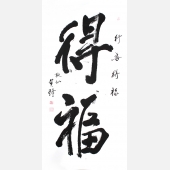China's Contemporary Art Market is Becoming more Rational
2011-04-15 11:39:21

Like just about everything else, art has taken a tumble in the global financial crisis, and the art scene in Shanghai is, well, waiting for better times.
People aren't spending like they used to. Small galleries are shuttered, and the regular art events are smaller.
Some artists choose not to sell until the market improves, some are getting regular jobs and hungry artists are even hungrier.
Yes, prices are going down (though not for the big names), and it could be a good time to invest.
As for the once-sizzling contemporary Chinese art scene, here's the view from Sotheby's auction house:
"Unlike the former overheating phenomena, China's contemporary art market is undergoing an adjustment phase and becoming more rational," says Wang Jie, chief representative in Shanghai for Sotheby's. "The economic downturn does have some effect on the market. However, an artwork's price mainly depends on its own quality."
Here on the ground, Wu Ruizhong has been dejected since he recently had to close down his gallery of contemporary oils on Fenyang Road.
"I didn't expect to make big money in my gallery - it's a purely personal interest," says Wu who has other investments in stocks and real estate. "But in such a critical period, my personal pursuit becomes a luxury."
The local art market seems to be going into hibernation, though, of course, the big shows and events will still go on.
"We hardly sold anything in the past several months," says Chen Yan, owner of Yibo Gallery on Yangshupu Road in the northern part of the city. "But we are already braced for the worst situation."
Echoing Chen, ShanghART Gallery spokeswoman Helen Yu says, "there are fewer buyers and even fewer visitors coming to the gallery these days."
There isn't much collecting hunger, no art fever as in the past.
"Some buyers are still waiting, biding their time with money in their pocket," says Chen. "They treat artwork like stocks: They want to purchase some artworks at the bottom price, just as they did in the stock market."
Certainly some prices come down as artists and galleries ask less. Some don't.
"We won't lower the price of the artworks in our gallery," says Yu from ShanghART. "This is not the rule for gallery operation."
If prices were lowered, says Chen from Yibo Gallery, "then how could we explain to those buyers who purchased artwork earlier? Credibility is very crucial in running a gallery."
Unlike those small galleries scattered around the city, Yibo and ShanghART benefited greatly from the fever to buy Chinese contemporary art in the past few years.
"At that time, everything displayed at the gallery could be sold immediately, whether it was good or bad," says Chen. "Our problem was not to find the buyers, but to convince the artists to give us artworks. Sounds a bit crazy?"
The boom in the Chinese contemporary art market reached its peak in 2005.
The astronomical price tags for the "Big Four" (Fang Lijun, Yue Minjun, Zhang Xiaogang and Wang Guangyi) - pioneering figures in contemporary art - shocked the art world. One work by Zhang could easily fetch 40 million yuan (US$5.85 million).
"Certainly there are some overseas investors or risky funds that manipulate the price," Chen says. "Suddenly the demand for the works of the 'Big Four' greatly exceeds their production."
So artists, big galleries and auction houses are sitting tight.
"There have been bubbles in the market," says Chen, "so we have to be cautious in choosing our customers, in case someone just turns around and sells what he just bought at auction for bigger profit."
The financial crisis has dried up capital and consequently, the works of the "Big Four" face bidding failure.

 黄琦
黄琦 测试用艺术
测试用艺术
